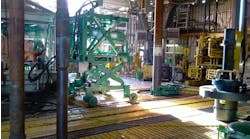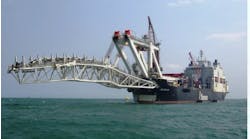Custom hot tapping machine plays pivotal role
Michel Courbat
T.D. Williamson S.A.
Technip was recently contracted by Burullus Gas Co. (Burullus) to tie in an expansion to its existing subsea West Delta Deep Marine (WDDM) facilities. To accomplish this, it was necessary to tie in a new 36-in. gas trunkline pipeline, which is part of the Phase VII project, to the existing system under pressure without shutting down production. To perform the tie-in, Technip retained T.D. Williamson S.A. (TDW) to carry out three subsea hot tap intervention operations.
Two traditional 16-in. hot tap operations would be completed on a 26-in. pipeline, and one innovative 20-in. hot tap on a 36-in. pipeline. To ensure that the hot tap interventions would be successful, it was necessary to engineer, install and pre-commission two hot tap assemblies, including one capable of cutting through a blind weld-neck "tappable flange" made of duplex stainless steel on the 36-in. line.
Hot tap machine
In preparation for the operation that would take place in depths to 95 m (311 ft), TDW worked with a Belgium-based engineering and construction specialist to produce the special hot tap tool known as a "cutter." This special tool would be used for the 20-in. hot tap and would need the ability to effectively cut the duplex plate. Since the duplex has a very high mechanical strength – meaning that it has a high elongation before reaching breaking point and a high level of hardenability – the cutting process employed must be very rigid and vibration-free while using the TDW Model 936D subsea tapping machine.
Working at TDW's facility in Nivelles, Belgium, a series of engineering, design and preliminary tests was performed. The first step involved engineering several alternative designs. The first alternative consisted of using either a proven cutter design; or that proven design updated with various teeth geometry. However, this option was not pursued because it could not penetrate the duplex stainless steel.
A second option involving removable teeth and welded teeth support was considered, but this was rejected due to its inability to resist vibration.
Ultimately, the design selected for fabrication featured a subsea electro-pump to supply adequate hydraulic power, a pilot drill with bronze plates to reduce vibration, and a specially manufactured set of cutters with removable cutting teeth that would be able to penetrate duplex stainless steel without breaking.
Preliminary trials
After the design was finalized, materials were procured and the prototype was fabricated and made ready for the first phase of testing: the internal preliminary trials.
During a period of eight weeks, the prototype was subjected to rigorous testing associated with a number of capabilities. The cutter's ability to make deep cuts on a plate of the same type of duplex stainless steel as the blind weld-neck "tappable flange" on the pipeline was an initial challenge.
The team made material and design improvements, ultimately achieving a prototype that could produce a smooth and satisfactory cutline. In addition, special bronze guides were developed and installed on the pilot drill to control vibration.
By the end of the four-month trial period, several renditions of the prototype had been used to complete four tapping operations. Before and after each cutting trial, visual and nondestructive examinations (NDE) of the cutters and pilot drills were carried out. The final prototype, which featured dual sets of cutting teeth and the pilot drill with the bronze guides, performed well. As the hot tap machine would be required to operate at an average pressure of 100 bar, pressure tests were undertaken to satisfy the requirements of the forthcoming factory acceptance test. The decision was then made to proceed to the second stage: the official trials.
Official trials
During the official trials three tapping operations were carried out with the custom machine. Two hot taps were completed on duplex plate, and one cold tap was executed through equal duplex tappable plate. These tapping operations revealed that the equipment endured the rigorous process, remained properly aligned and cut the duplex steel plate effectively. These operations took place as part of a requisite system integration test (SIT), which confirmed the following:
- The teeth accurately cut the duplex stainless steel
- The pilot drill remained rigid and vibration-free
- The design of the cutter was improved by adjusting the teeth support.
It also proved that the tapping machine could be unset in the middle of the cut and reset while reaching the cut back without causing the tapping machine to be misaligned or moved out of proper position.
With the official trials of the custom hot tap cutter successfully completed, the system received approvals from Burullus, Technip, and the Burullus Independent Verification Authority to perform the subsea operation well in advance of the project mobilization. In preparation for the impending operation, two hot tap machines were produced in order to guarantee 100% back-up of this critical piece of equipment.
Maintaining gas pressure
For three weeks, TDW worked from Technip's dive support vesselWellservicer to carry out all three hot taps. Throughout the process, a prevailing pressure of 100 bar (1,450 psi) was successfully maintained in the existing gas export system. The innovative hot tap on the duplex tappable flange required just six days to complete.
In spite of the fact that the hot tap intervention was carried out subsea, making it more complicated to mobilize and install equipment than when working onshore, the operation was carried out by skilled divers as intended, with no lost time incidents or production downtime.
Much of the success was attributed to the investment in planning and pre-operational equipment trials and testing. TDW worked with the Technip and Burullus teams to ensure that the operation would proceed like clock-work, and that the customized cutting tool would operate effectively on duplex stainless steel. As a result, the operation provided three tie in points, preparing the way for Technip to successfully tie-in the new 36-in. gas trunkline for the WDDM Phase VII development.
The author
Michel Courbat is offshore project manager for T.D. Williamson S.A.
Offshore Articles Archives
View Oil and Gas Articles on PennEnergy.com






